Related Research Articles
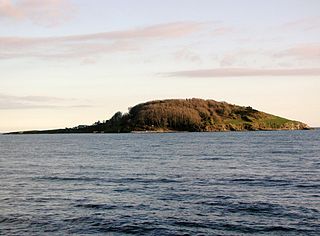
Looe Island, also known as St George's Island, and historically St Michael's Island is a small island nature reserve a mile from the mainland town of Looe off Cornwall, England.
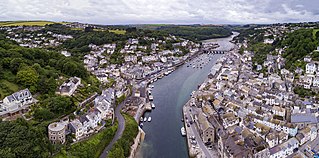
Looe is a coastal town and civil parish in south-east Cornwall, England, United Kingdom, with a population of 5,280 at the 2011 census.

The Liskeard and Looe Union Canal was a broad canal between Liskeard and Looe in Cornwall, United Kingdom. It was almost 6 miles (9.7 km) long and had 24 locks, and it opened progressively from 1827. The engineer was Robert Coad.

Liskeard is an ancient stannary and market town in south-east Cornwall, England, United Kingdom. It is situated approximately 20 miles (32 km) west of Plymouth, 14 miles (23 km) west of the Devon border, and 12 miles (20 km) east of Bodmin. The Bodmin Moor lies to the north-west of the town. The total population of the town at the 2011 census was 11,366
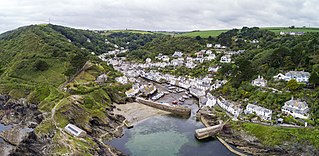
Polperro is a large village, civil parish, and fishing harbour within the Polperro Heritage Coastline in south Cornwall, England, United Kingdom. Its population is around 1,554.

The Looe Valley Line is an 8+3⁄4-mile (14 km) community railway from Liskeard to Looe in Cornwall, England, that follows the valley of the East Looe River for much of its course. It is operated by Great Western Railway.

The River Looe is a river in south-east Cornwall, which flows into the English Channel at Looe. It has two main branches, the East Looe River and the West Looe River. The eastern branch has its source near St Cleer only 0.31 miles (0.5 km) away from the Golitha Falls on the River Fowey, and flows south, passing close to the western outskirts of Liskeard. The western branch has its source near Dobwalls.

Hayle is a port town and civil parish in west Cornwall, England, United Kingdom. It is situated at the mouth of the Hayle River and is approximately seven miles (11 km) northeast of Penzance.

Liskeard railway station serves the town of Liskeard in Cornwall, England. The station is approximately 18 miles (29 km) west of Plymouth on the Cornish Main Line and 264 miles 71 chains (426.3 km) from London Paddington via Box and Plymouth Millbay. It is the junction for the Looe Valley Line. The railway station is situated approximately 0.5 miles (0.80 km) south-west of Liskeard town centre.
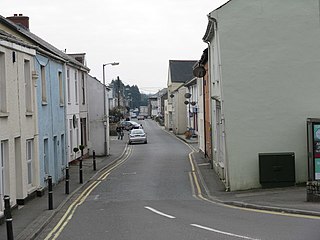
St Blazey is a small town in Cornwall, England, United Kingdom.

Talland is a hamlet and ecclesiastical parish and former civil parish, between Looe and Polperro, now in the parish of Polperro, in the Cornwall district, on the south coast of Cornwall, England. It consists of a church, the Old Vicarage and a few houses. In 1931 the parish had a population of 768. On 1 April 1934 the civil parish was abolished and merged with Lansallos, part also went to form Looe.
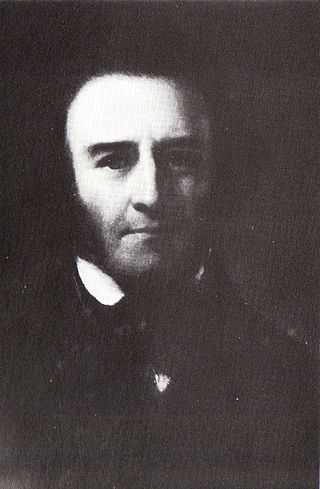
James Meadows Rendel FRS was a British civil engineer.
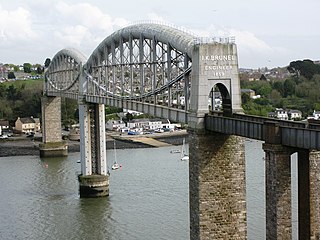
The Cornish Main Line is a railway line in Cornwall and Devon in the United Kingdom. It runs from Penzance to Plymouth, crossing from Cornwall into Devon over the Royal Albert Bridge at Saltash.
The Liskeard and Looe Railway was a railway originally built between Moorswater, in the valley west of Liskeard, and Looe, in Cornwall, England, UK, and later extended to Liskeard station on the Cornish Main Line railway. The first section was opened in 1860 and was owned by the Liskeard and Looe Union Canal Company, whose canal had earlier been built to convey sea sand and lime up the valley of the East Looe River, for the purpose of improving agricultural land.

Lanteglos is a coastal civil parish in south Cornwall, England, United Kingdom. It is on the east side of the tidal estuary of the River Fowey which separates it from the town and civil parish of Fowey. The South West Coast Path runs along the southern coasts of the parish and much of the southern part of the parish lies in the Polruan to Polperro Site of Special Scientific Interest managed by the National Trust.

St Martin-by-Looe is a coastal civil parish in south Cornwall, England, United Kingdom. The parish is immediately east of the town and parish of Looe, seven miles (11 km) south of Liskeard. The parish is in the Liskeard Registration District and the population in the 2001 census was 321, which had increased to 429 at the 2011 census.

Fishing in Cornwall, England, UK, has traditionally been one of the main elements of the economy of the county. Pilchard fishing and processing was a thriving industry in Cornwall from around 1750 to around 1880, after which it went into an almost terminal decline. During the 20th century the varieties of fish taken became much more diverse and crustaceans such as crab and lobster are now significant. Much of the catch is exported to France due to the higher prices obtainable there. Though fishing has been significantly damaged by overfishing, the Southwest Handline Fishermen's Association has started to revive the fishing industry. As of 2007, stocks were improving. The Cornwall Sea Fisheries Committee is one of 12 committees responsible for managing the corresponding Sea Fisheries District. The Isles of Scilly Sea Fisheries Committee is responsible for the Scilly district.
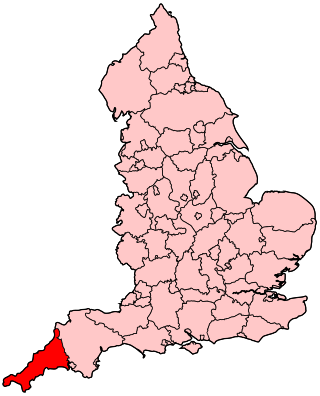
The following outline is provided as an overview of and topical guide to Cornwall: Cornwall – ceremonial county and unitary authority area of England within the United Kingdom. Cornwall is a peninsula bordered to the north and west by the Celtic Sea, to the south by the English Channel, and to the east by the county of Devon, over the River Tamar. Cornwall is also a royal duchy of the United Kingdom. It has an estimated population of half a million and it has its own distinctive history and culture.
Presented below is an alphabetical index of articles related to Cornwall:

Looe Bridge is a bridge in Looe, Cornwall, across the River Looe. Built in the 1850s to replace a dangerous 15th-century structure, the bridge carries the A387 road and is a Grade II listed building.
References
- 1 2 Cornwall Industrial Settlements Initiative — Looe www.historic-cornwall.org.uk. Retrieved on 13 November 2016
- 1 2 3 4 Grace's Guide to British Industrial History - Joseph Thomas www.gracesguide.co.uk Retrieved on 8 November 2018
- 1 2 3 Endless Tales — Joseph Thomas tidan-likida.livejournal.com. Retrieved on 13 November 2016
- ↑ South-West Coast Path — Looe, Talland and Polperro www.southwestcoastpath.org.uk. Retrieved on 13 November 2016
- 1 2 Engineering Timelines — Banjo Pier www.engineering-timelines.com. Retrieved on 13 November 2016
- ↑ England & Wales, National Probate Calendar (Index of Wills and Administrations), 1858-1966, 1973-1995